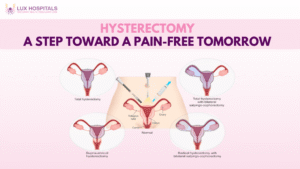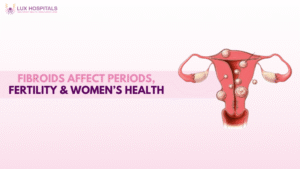Benefits and Risks of Myomectomy

Myomectomy is a surgical procedure performed to remove uterine fibroids while preserving the uterus. It is often recommended for women experiencing severe fibroid-related symptoms such as heavy menstrual bleeding, pelvic pain, and fertility issues. Unlike a hysterectomy, which removes the entire uterus, myomectomy allows women to retain their reproductive organs, making it a preferred choice for those who wish to conceive in the future. However, like any surgical procedure, myomectomy has benefits and risks.
Benefits of Myomectomy
1. Relief from Symptoms
One of the primary reasons women undergo a myomectomy is to alleviate the symptoms caused by fibroids. These symptoms can include heavy or prolonged menstrual bleeding, pelvic pain, frequent urination, and bloating. Removing fibroids can provide significant relief and improve the quality of life.
2. Preservation of the Uterus
For women who wish to conceive, myomectomy is a beneficial option as it removes fibroids while keeping the uterus intact. This is particularly important for women who are planning pregnancy, as fibroids can sometimes interfere with conception and increase the risk of miscarriage.
3. Improved Fertility
Women struggling with infertility due to fibroids may find myomectomy helpful in enhancing their chances of conception. By removing fibroids that distort the uterine cavity or block the fallopian tubes, this procedure can improve reproductive outcomes and increase the likelihood of a successful pregnancy.
4. Alternative to Hysterectomy
A myomectomy offers a uterus-preserving alternative to hysterectomy. Many women prefer this procedure as it allows them to avoid the hormonal and emotional changes associated with the removal of the uterus.
5. Various Surgical Approaches
Myomectomy can be performed using different techniques, depending on the size, location, and number of fibroids. The three main types include:
- Laparoscopic Myomectomy – A minimally invasive procedure that involves small incisions and the use of a camera to remove fibroids.
- Hysteroscopic Myomectomy – A procedure performed through the vagina and cervix to remove fibroids from the uterine cavity.
- Abdominal Myomectomy – An open surgery method used for larger or deeply embedded fibroids.
Risks of Myomectomy
While myomectomy provides numerous benefits, it is essential to be aware of the potential risks and complications associated with the procedure.
1. Risk of Laparoscopic Myomectomy
Laparoscopic myomectomy, though minimally invasive, carries risks such as excessive bleeding, infection, and injury to surrounding organs. In some cases, fibroids may recur, requiring additional treatment.
2. Surgical Complications
As with any surgery, myomectomy carries risks such as excessive bleeding, infection, and anesthesia-related complications. In some cases, a blood transfusion may be necessary if there is significant blood loss.
3. Scar Tissue Formation
After a myomectomy procedure, scar tissue (adhesions) may develop inside the uterus or surrounding organs, potentially leading to pelvic pain or fertility issues.
4. Uterine Rupture During Pregnancy
Women who undergo myomectomy, particularly abdominal or deep fibroid removal, may have a weakened uterine wall. This increases the risk of uterine rupture during pregnancy, especially if they plan to have a vaginal delivery. In many cases, doctors recommend a cesarean section for future pregnancies.
5. Fibroid Recurrence
One of the side effects of myomectomy surgery is the potential recurrence of fibroids. While the procedure removes existing fibroids, new ones can develop over time, leading to the possibility of future treatments.
6. Impact on Fertility
While myomectomy can enhance fertility, in some cases, it may lead to complications such as scarring in the uterus, which might affect implantation or increase the risk of miscarriage.
7. Recovery and Downtime
The recovery period varies depending on the type of myomectomy performed. A laparoscopic or hysteroscopic myomectomy generally has a shorter recovery time, whereas an abdominal myomectomy may require several weeks of healing. Women should plan for adequate rest and follow post-surgery care instructions to ensure proper recovery.
Conclusion
Myomectomy is a valuable surgical option for women suffering from symptomatic fibroids who wish to preserve their fertility. It offers significant relief from fibroid-related symptoms and improves the chances of conception. However, it is crucial to be aware of the associated risks, such as fibroid recurrence, surgical complications, and potential impact on pregnancy.
Consulting with a qualified healthcare provider will help determine the best treatment approach based on individual needs and medical history. If you are considering myomectomy, discuss the benefits and risks of myomectomy with your doctor to make an informed decision about your reproductive health.
What are the benefits of myomectomy?
The benefits of myomectomy include relief from heavy bleeding and pelvic pain, preservation of the uterus, improved fertility, and an alternative to hysterectomy for women who want to retain their reproductive ability.
What should I do to reduce risks after Myomectomy?
To reduce risks after myomectomy, follow post-surgical care instructions, avoid heavy lifting, stay hydrated, eat a balanced diet, take prescribed medications, monitor for complications, and attend follow-up appointments.
Is myomectomy a high risk surgery?
Myomectomy is generally safe but carries some risks, such as bleeding, infection, scarring, and fibroid recurrence. The risk level depends on the type of procedure and individual health factors.
What are the risks of Laparoscopic Myomectomy?
The risk of laparoscopic myomectomy includes excessive bleeding, infection, damage to surrounding organs, and the possibility of fibroid recurrence.
Is there a risk of fibroids coming back after Myomectomy?
Yes, fibroids may recur even after removal, especially in younger women or those with a family history of fibroids. Regular follow-ups with a doctor can help monitor recurrence.
What are the side effects of Myomectomy surgery?
Some side effects may include post-surgical pain, swelling, fatigue, and temporary menstrual irregularities. In some cases, scarring inside the uterus can affect implantation.
How soon can I try to conceive after a Myomectomy?
Doctors typically recommend waiting 3 to 6 months after surgery before trying to conceive, allowing the uterus to heal properly.
Frequently Asked Questions
The benefits of myomectomy include relief from heavy bleeding and pelvic pain, preservation of the uterus, improved fertility, and an alternative to hysterectomy for women who want to retain their reproductive ability.
To reduce risks after myomectomy, follow post-surgical care instructions, avoid heavy lifting, stay hydrated, eat a balanced diet, take prescribed medications, monitor for complications, and attend follow-up appointments.
Myomectomy is generally safe but carries some risks, such as bleeding, infection, scarring, and fibroid recurrence. The risk level depends on the type of procedure and individual health factors.
The risk of laparoscopic myomectomy includes excessive bleeding, infection, damage to surrounding organs, and the possibility of fibroid recurrence.
Yes, fibroids may recur even after removal, especially in younger women or those with a family history of fibroids. Regular follow-ups with a doctor can help monitor recurrence.
Some side effects may include post-surgical pain, swelling, fatigue, and temporary menstrual irregularities. In some cases, scarring inside the uterus can affect implantation.
Doctors typically recommend waiting 3 to 6 months after surgery before trying to conceive, allowing the uterus to heal properly.




















